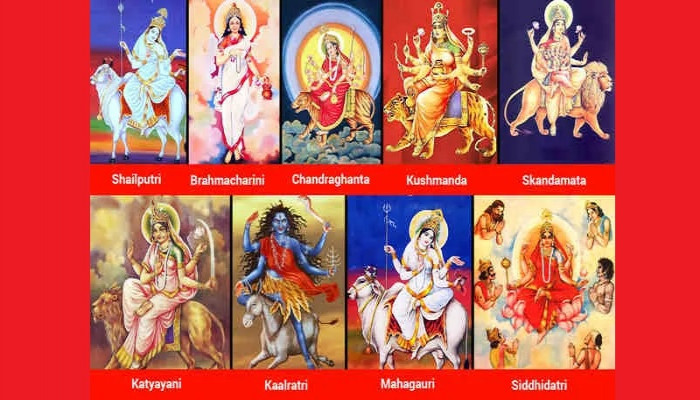Navratri: A perspective of Devi Shakti from Veda to Vedanta to Cosmos
- In Religion
- 05:28 PM, Oct 02, 2025
- Rudra Dubey
Navratri to Internal Embodiment of Invocation of Devi Shakti
Navratri, literally meaning nine nights, is one of the most celebrated festivals in India, observed with devotion across diverse regions. It is a time to do Atmsat (internalisation) and Aaradhana (invocation) of Devi Shakti, the primordial energy that sustains the universe. Over nine nights and ten days, devotees worship the Navadurga—the nine manifestations of the goddess Durga, each representing a distinct cosmic force guiding the cycle of creation, sustenance, and transformation.
The term Shakti—meaning power, energy, or dynamic force—traces its deepest roots to the Devi Sukta of the Rig Veda. In this hymn, the seer Rishi Ambhrini proclaims:
“Aham rashtrī sangamanī vasunām…” — “I am the sovereign power, the gatherer of treasures…”
Here, the feminine voice identifies herself as the source of all movement, the breath behind gods and men, the principle through which cosmic order flows. This early articulation of the feminine divine gave rise to the later concept of Shakti: the power without which even the supreme consciousness (Shiva) remains inert.
Ancient Indian seers intuited the universe as vibration, sound (nada), and energy (Shakti). Modern physics echoes this insight.
nāsad āsīn no sad āsīt tadānīṁ nāsīd rajo no vyomā paro yat |
kim āvarīvaḥ kuha kasya śarmann ambhaḥ kim āsīd gahanaṁ gabhīram || 1 ||
Then even nothingness was not, nor existence,
There was no air then, nor the heavens beyond it.
What covered it? Where was it? In whose keeping
Was there then cosmic water, in depths unfathomable?
String Theory: reality as vibrating strings, resonant with nada brahma—the universe as sound. Quantum Theory: matter as energy fields and probabilities, paralleling Shakti as the unseen substratum. Dance of Nataraja: Shiva’s dance of creation and destruction, powered by Shakti, is mirrored in the quantum dance of particles appearing and disappearing.
The Nine Forms of Shakti is a Representation of the Formation of Shrishti
The Navadurga represents an unfolding journey of Shakti—from innocence to transcendence, from material grounding to cosmic liberation. It is the eternal rhythm of Shakti: emergence, manifestation, dissolution, and return to the unmanifest mystery.
In Vedic thought, creation is not a single event but a continuous unfolding of consciousness through energy—Shiva through Shakti, Purusha through Prakriti. The nine forms of Shakti (Navadurga) can be understood as stages of cosmic manifestation, each echoed in the hymns of the Veda.
1. Shailaputri – The Grounding of Matter
The beginning of a life, a daughter of the mountains, symbolising stability and rootedness
Rig Veda 10.81.1:
"He is the one who fixed firm the earth and spread out the sky above; who gave life its foundation."
2. Brahmacharini – Tapas, the Fire of Creation
Embodiment of essence (prakritya) and discipline (prakritikacharan), guiding spiritual pursuit.
Rig Veda 10.129.3 (Nasadiya Sukta):
"Darkness there was, concealed in darkness, all this was an undifferentiated flood. That which became was born through the power of heat (tapas)."
3. Chandraghanta – The Dawn of Light
Radiance of essence, courage, dispelling fear of breaking Moha (attachment) and Trishna (evil).
Rig Veda 1.113.1:
"The radiant dawn has awakened, revealing all, dispelling darkness with her light."
4. Kushmanda – The Cosmic Womb
(Kushm + and) The cosmic womb, creator of the universe with her smile.
Rig Veda 10.129:
The Nasadiya Sukta is the creation hymn that provides the origin of the universe through profound questions and the recognition of human limitations in understanding ultimate reality.
Rig Veda 10.121.1:
"In the beginning arose the Golden Embryo; he was the one Lord of all that is born."
5. Skandamata – The Nurturer of Cosmic Order
Mother of Kartikeya, create a Self, internally and externally, nurturing divine leadership and courage.
Rig Veda 1.164.33:
"By the Mother are sustained these diverse worlds; in her womb all beings rest."
6. Katyayani – The Warrior Force
Manifest Shakti (energy) embodied in the self and be a fierce warrior, destroyer of demons, giver of justice
Rig Veda 10.125.6 (Devi Sukta):
"I bend the bow for Rudra, that his arrow may strike down the hater of prayer. I rouse and order the battle for the people."
7. Kalaratri – The Night of Dissolution
Be on the Kal (time dimension) and prepare to detach and transcend. Be the dark and terrifying form, symbolising the destruction of Agyan (ignorance and Moh/Sansar (attachments).
Rig Veda 10.129.5 (Nasadiya Sukta):
"In the beginning, there was neither death nor immortality, no sign of night or day. That One breathed, windless, by its own power."
8. Mahagauri – The Purification
Be in the state of Shunya/Sthir (Nothingness/Stillness), attain serene, radiant purity, granting peace and grace.
Rig Veda 1.164.20:
"From the One has arisen the shining purity; sages behold it as manifold though it is one."
9. Siddhidatri – The Supreme Unity
Transcendent. Bestower of ultimate powers (siddhis), leading to liberation.
Rig Veda 10.129.7 (Nasadiya Sukta):
"He, the first origin of this creation, whether he formed it all or did not, he who surveys it from the highest heaven—he alone knows, or perhaps he knows not."
Together, these forms map the aspirant’s spiritual journey—from grounding in matter to ascending into transcendental awareness, and the Navadurga cycle mirrors the Vedic hymns:
Darkness → Tapas → Light → Cosmic Womb → Sustenance → Protection → Dissolution → Purity → Transcendence.
Vedanta Insights: Shakti and the Path of Transcendence
If the Veda sings of Shakti’s cosmic unfolding, Vedanta teaches the seeker how to transcend through her grace. The Upanishads and the Bhagavad Gita align beautifully with the Navadurga journey, guiding from material grounding to spiritual liberation.
- Shailaputri – Foundation in Dharma
Bhagavad Gita 6.16–17:
"Yoga is not for one who eats too much or too little… moderation is the foundation." - Brahmacharini – Discipline and Tapas
Kaṭha Upanishad 1.2.23:
"The Self cannot be attained by learning, nor by intellect… He is attained only by the one whom He chooses." - Chandraghanta – Awakening of Inner Light
Chandogya Upanishad 6.8.7:
"Tat tvam asi, Śvetaketo – Thou art That." - Kushmanda – The Cosmic Womb
Mundaka Upanishad 2.1.1:
"As a spider projects and withdraws its web… so from the Imperishable arises this universe." - Skandamata – Motherly Sustenance
Bhagavad Gita 9.10:
"Under My guidance, Prakriti gives birth to all moving and unmoving beings." - Katyayani – The Force of Liberation
Bhagavad Gita 4.7–8:
"Whenever dharma declines… I manifest Myself, to protect the good, to destroy the wicked, to establish dharma." - Kalaratri – Facing Dissolution
Bṛhadāraṇyaka Upanishad 2.3.6:
"Neti, neti — not this, not this. The Self is beyond all attributes and forms." - Mahagauri – Purity of Knowledge
Bhagavad Gita 5.18:
"The wise see the same in a Brahmin, a cow, an elephant, a dog, and one who eats dog’s flesh." - Siddhidatri – Transcendence and Liberation
Mundaka Upanishad 2.2.5:
"When the seer sees the luminous Maker, the source of Brahman, then he becomes free, beyond virtue and vice."
Thus, Navratri is not only devotion to the nine forms of Devi but also a Vedantic pilgrimage: from grounding, to awakening, to purification, to liberation.
Thus, Shakti is not only theological but cosmological—a bridge between spirituality and transcendental path of Atman/Brahm (self) to Param Brahm (ultimate reality)--Aham Brahmasmi (I am the ultimate reality), one of the four Mahavakyas ("Great Sayings") ( Brihadaranyaka Upanishad).
Navratri is more than ritual; it is a living philosophy of energy, consciousness, and creation. The nine forms of Devi invite us to reflect on the stages of cosmic evolution, personal transformation, and ultimate transcendence. The Vedas sing of Shakti’s cosmic emergence, the Upanishads and Vedanta guide the seeker to transcendence, and modern physics glimpses the same dance of energy. Without Shakti, there is no motion, no creation, no cosmos. Navratri, then, is not only devotion to the goddess but reverence for the universal principle of energy itself—the pulse that sustains life, stars, and galaxies alike.
Disclaimer: The opinions expressed within this article are the personal opinions of the author. MyIndMakers is not responsible for the accuracy, completeness, suitability, or validity of any information on this article. All information is provided on an as-is basis. The information, facts or opinions appearing in the article do not reflect the views of MyindMakers and it does not assume any responsibility or liability for the same.







Comments